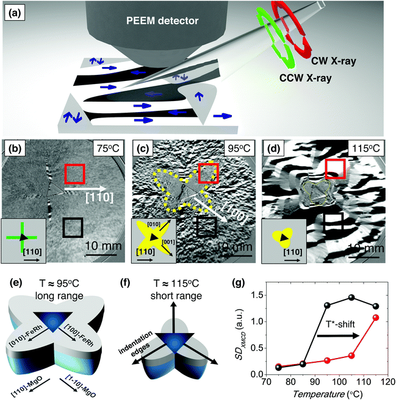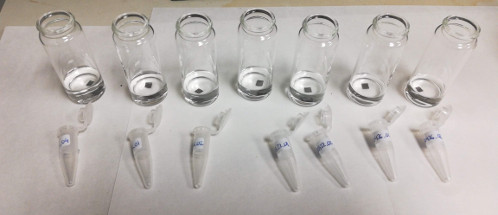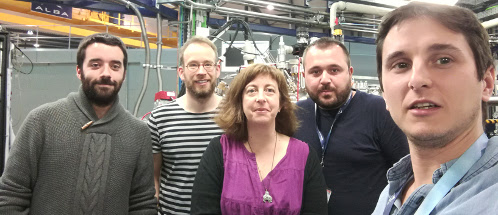
a) Schematic representation of the experimental set-up for X-rays magnetic circular dichroism and photoemission electron microscopy experiments (XMCD-PEEM). The black and white areas account for domains with net magnetization along and opposite to the direction of the incident light, respectively. Grey regions correspond to either domains without net magnetization (in our case antiferromagnetic domains), or domains with net magnetization perpendicular to the incident light. CCW and CW correspond to anticlockwise and clockwise X-ray light, respectively. (b)–(d) XMCD-PEEM magnetic domain images of the FeRh film region with a 300 mN indentation measured at 75 °C, 95 °C and 115 °C, respectively. Insets show schematic representations of the image symmetry. (e) and (f) Sketch of the antiferromagnetic regions after indentation in the FeRh/MgO system, as deduced from the XMCD-PEEM characterization, at the indicated temperatures. (g) Magnetic contrast of the XMCD images (SDXMCD) of the regions enclosed in red (near indentation) and black (far from the indentation) in (b)–(d).
Cerdanyola del Vallès, 26th May 2020 Some memory devices where information from smartphones and computers is stored are based on a very precise control of the magnetic properties, at nanoscopic scale. The more precise this control is, the more storage capacity and speed they can have. In certain cases, the combination of ferromagnetism (where the magnetism of all the atoms in the material points in the same direction) and antiferromagnetism (where the magnetism of the atoms in the material points alternately in opposite directions) is used to store the information. One of the materials that can show these two arrangements is the alloy of iron and rhodium (FeRh), because it shows a metamagnetic transition between these two phases at a temperature very close to room temperature. In particular, it can change state from antiferromagnetic to ferromagnetic simply when heated. The antiferromagnetic state is more robust and secure than the ferromagnetic one, since it is not easily altered by the presence of magnets in its proximity, i.e. an external magnetic field cannot erase the information easily.
A team of researchers from the UAB, the ICMAB and the ALBA Synchrotron, along with scientists from the University of Barcelona and the Catalan Institute of Nanoscience and Nanotechnology, have used mechanical pressure to modify this transition and stabilize the antiferromagnetic state. The researchers have observed that pressing the surface of the iron-rhodium alloy with a nanometer-sized needle causes the magnetic state to change in a simple and localized way. By pressing on different areas of the material, the researchers have managed to generate antiferromagnetic nano-islands embedded in a ferromagnetic matrix, a very difficult task with the current techniques available. If the process is repeated over the entire surface of the alloy, the new technique can induce this change across large areas of the material drawing patterns with nanoscopic resolution with areas with different magnetic properties, generating structures as small as those that can currently be achieved using more complex methods.
Improvement to miniaturize magnetic devices
This is a major improvement to miniaturize the patterns that can be built with magnetic materials, an improvement in the resolution of the tools that engineers use to design the magnetic devices of the technology we use daily. "The idea is very simple", explains Ignasi Fina, researcher at the ICMAB-CSIC, "in phase transitions, everything you do to the material has a great impact on the other properties. Our alloy has a magnetic phase transition. With a nanometer-sized needle we change the magnetic order just by pressing the material. Specifically, it changes from ferromagnetic to antiferromagnetic. And since the needle is nanometric, the change is at the nanoscale."
"The new technique based on the application of pressure using nanoneedles can allow the construction of magnetic nanometric devices with much smaller structures and much more robust and safe than the current ones, facilitating the manufacture of magnetic memories with different architectures that improve their capacities", says ICREA researcher from the Department of Physics at the UAB, Jordi Sort.
There are other techniques based on the application of voltage or intense magnetic fields to increase the stability of the antiferromagnetic phase of the alloy, but they cause large-scale changes in the entire material, which limit its control and miniaturization capacity. Applying pressure in a very localised manner offers unprecedented accuracy, affecting only small local areas at the nanometric scale. When pressing, the transition temperature of the alloy increases, the temperature at which its state changes, which involves the change in its magnetization.
In order to resolve the magnetic changes around an individual indentation on the nanoscale, the work used the Photoemission Electron Microscopy combined with X -ray magnetic circular dichroism at the CIRCE-PEEM beamline of the ALBA Synchrotron. "Our synchrotron light-based techniques make possible to resolve the changes on a really small scale", explains Michael Foerster, beamline scientist at ALBA.
Applications in other fields
The possible applications go beyond magnetic materials. The fact of modifying the properties of a material by applying pressure, i.e., by modifying the cell volume of its crystalline structure, can be extrapolated to other types of materials. Researchers believe that this technique opens the door to a new way of nanostructuring the physical and functional properties of materials, and of implementing new architectures in other types of non-magnetic nanodevices and microdevices.


Left: some samples of FeRh metamagnetic material, ready to be analised at the ALBA Synchrotron. Right: Part of the research team. The research has been highlighted on the cover of the latest edition of the journal Materials Horizons. Led by researchers Ignasi Fina, ICMAB-CSIC, Jordi Sort, ICREA in the Department of Physics at the UAB, and Michael Foerster, beamline scientist at CIRCE-PEEM from ALBA, the research has also involved Enrique Menéndez, Alberto Quintana and Daniel Esqué de los Ojos (Department of Physics at the UAB); Carlos Gómez-Olivella (Department of Applied Physics and Optics, UB); Oriol Vallcorba and Lucía Aballe (ALBA); Carlos Frontera (ICMAB-CSIC); Josep Nogués (ICREA at the ICN2); and Emerson Coy (NanoBioMedical Center, Adam Mickiewicz University).
Reference: Michael Foerster, Enric Menéndez, Emerson Coy, Alberto Quintana, Carles Gómez-Olivella, Daniel Esqué de los Ojos, Oriol Vallcorba, Carlos Frontera, Lucia Aballe, Josep Nogués, Jordi Sort and Ignasi Fina. Local manipulation of metamagnetism by strain nanopatterning, Materials Horizons (2020) https://doi.org/10.1039/D0MH00601G




